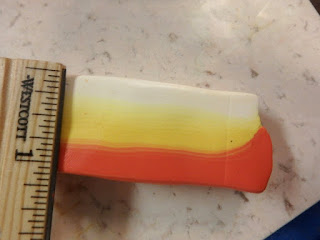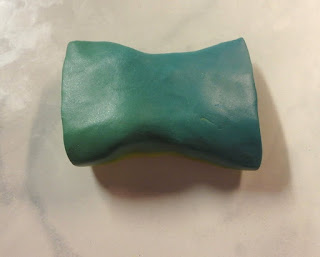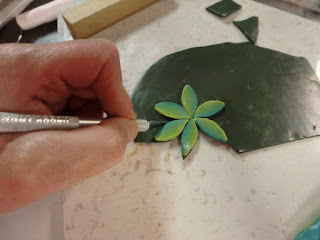We made spotted lilies at our August workshop. Here are two flowers I made using this technique. The pink lily requires 2 ounces of the deepest color, 2 ounces of the middle color and 2 ounces of white. The each petal is about 1 and 1/2 inches long. Each petal on the shades of orange and white lily is 1 inch long.
This lily took the class almost four hours to complete. Lilian helped us by making the Skinner blend leaf cane for us. The four hours included demonstrations by Lilian and a brief lunch break. While we ate we talked about the cane so we lost very little time. The two I have made at home took less time because I learned each time I made a cane.
To begin with, I was taking photos of what we were doing but the last couple hours I spent all my time on creating my cane. I made the second cane, the smaller orange cane at home so I could get more photos of the steps...and I still missed a couple. I started a third cane, using orange, yellow and white and took additional photos. There should be enough information here so you can make a cane. I see lots of possibilities for these lilies besides using them as jewelry.
At our September workshop, Mary Ann brought in brooches and ear rings she made using the August technique.
The petals are raised enough so a chain can be slipped through turning the brooch into a pendant.
Here is my small orange shaded brooch from the side.
And now for the directions.
1. Make a Skinner blend. Most basic polymer clay books and magazines give directions for this blend.
2 Fold blend in thirds, folding white to white, middle color to middle color, deep color to deep color.
3. Run through the pastry maker at a medium setting.
4. Start from the light end.
Cut a rectangle about 1 and 1/4 inch wide. Lay it on the strip, Cut again. Continue cutting until you have a block of graduated color.
5.1 Compressing
5.2 Compressing
5.3 Continue until you have a block ( a little longer than wide perhaps).
6. Cut off the ragged ends and cut the remaining strip into 6 equal pieces.
Lay strips aside.
7. Make a bullseye cane. This will become the spots on the lily.
7.1 Make the core of this cane from the deepest color of the three you have chosen. It should be about 1/2 inch in diameter and no more than 2 inches long. (You will have more than enough for the spots.)
7.2 Wrap the core with the middle color sheet rolled to the second thinnest setting on the pasta maker.
7.3 Wrap with a sheet of white rolled to the second thinnest setting around the bullseye.
7.4 Roll the cane into a long very skinny snake. The left end is skinny enough. The right end needs more rolling.
7.5 Cut a total of 13 strips from this long skinny cane. Each one should be the length of the 6 strips you have set aside.
8.0 Lay the 13 skinny strips on as shown in the photo below. The top numbers denote the rolled strips. The bottom numbers correspond to the number of long skinny rolls on each strip.
8.1 Layer the strips...
Strip 4 with two long "snakes" goes on next
Strip 5 with 3 long "snakes" follows it.
Top the stack off with strip 6.
View from the end.
9. Turning the stack into a petal. Pinch ends together.
9.2 Compress and stretch.
9.3 Cut the petal cane into two logs.
9.4 Wrap one log with white.
9.5 Wrap the other log with middle color, then with white, then with the deepest color.
Set the petal canes aside.
10. Make a leaf cane. This can be a roll of green shaped to resemble a leaf or a Skinner blend stacked and shaped to resemble a leaf.
11. Slice off 6 leaves. Lay them on a dark green base. Cut around the leaves.
11.2 Make a small ball of clay and press it into the center.
12.0 Assembly. Cut three petals from the triple wrapped cane. Use a small diameter knitting needle or similar rod to aid in raising each petal above the leaf under it. Press leaf down on the ball at the center of the leaf cluster and also where the tip of the petal touches the pointed end of the leaf. Repeat skipping a leaf between each petal.
12.1 Apply 3 petals wrapped in white in the remaining spaces. Add a decorative center. Some crafters used small crystals. Others made a textured ball. I put a bead in the center of a ball of clay for this one.
Here are our first spotted lilies, fresh from the oven...30 minutes at 275 degrees Fahrenheit.
Annette, DeeDee, Linda, Lilian, Mary Ann and I contributed examples to this post.















































What fun and so very creative! I would love this class...but I already have too many hobbies! Always good to visit your blog! Say Hi to Tom:)
ReplyDeletePrecioso, lo voy a hacer, gracias por compartir 🤗🤗🤗⚘️⚘️⚘️⚘️
ReplyDelete